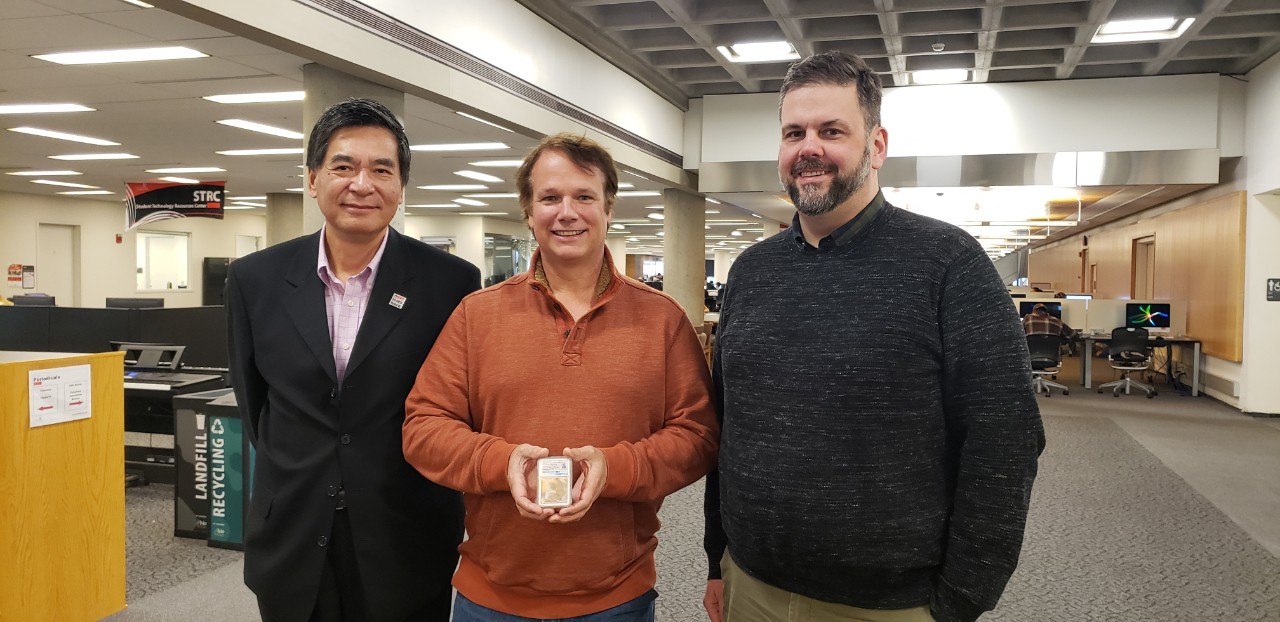
Armstrong brothers donate unique relic of aeronautical history to UC
UC exhibit now includes piece of fabric that was connected to Wright Brothers
If only that camel-colored piece of fabric could talk. It could tell us of man’s first flight — and what it is like to rocket to the moon.
At first glance, the 1.125-inch piece of fabric known as muslin might not look like much, but it came from the wing of the Wright Flyer, the aircraft built by the Wright Brothers — the first aircraft to carry a person in flight.
Anyone can now see this historic relic in UC’s College of Engineering and Applied Science Library as a part of the Neil Armstrong Commemorative Archive exhibit.

This 1.125-inch piece of fabric came from the wing of the Wright Flyer, the aircraft built by the Wright Brothers — the first aircraft to carry a person in flight.
On Dec. 17, 1903, Orville Wright took off in the Wright Flyer with Wilbur running beside him in Kitty Hawk, North Carolina. The premiere flight went an unprecedented 120 feet. But how did Neil Armstrong end up with the piece of wing now held in the UC collection?
Neil Armstrong — the man who become the first to walk on the moon — grew up in Ohio, like the Wrights. He admired the brothers and had similar aspirations to fly one day.
Armstrong came into possession of the artifacts through an arrangement with the U.S. Air Force Museum in Dayton, Ohio. He was asked to take remnants of the fabric and the propeller on the Apollo 11 mission — the first that would successfully land on the moon. Armstrong carried the pieces of the Wright Flyer along in his “personal preference kit,” a bag of significant belongings that each astronaut was allowed to load onto the lunar module, according to an article in Time.
After Armstrong’s death in 2012, his sons Mark and Rick Armstrong decided to donate some of them to various academic archives, including the University of Cincinnati Libraries.
“It is our hope,” says Mark Armstrong, “that this artifact, which harkens back to the heyday of our space program, as well as the very first moments of powered flight, will encourage innovation and inspire future generations of students to dream of ways to build a safer and stronger tomorrow.”
Dad selected the University of Cincinnati as the institution where he would continue to pursue his lifelong love of aeronautics. This — along with UC’s relentless efforts to build a world-class engineering program and our family’s passion for supporting our local community — makes UC Libraries the ideal place for this piece of aviation history.
Mark Armstrong
As it goes, Armstrong and Orville Wright both have direct ties to UC’s aerospace engineering program.
In 1929, Orville Wright partnered with Bradley Jones, the man the UC Board of Directors chose to head the nation’s first cooperative education program in aeronautical engineering. The two men developed the curriculum for UC’s aeronautical engineering program (now called aerospace engineering), which became the second program of its kind in the nation.
Decades later, Neil Armstrong became a professor of aeronautical engineering from 1971-79.
“Dad selected the University of Cincinnati as the institution where he would continue to pursue his lifelong love of aeronautics,” Mark Armstrong said. “This — along with UC’s relentless efforts to build a world-class engineering program and our family’s passion for supporting our local community — makes UC Libraries the ideal place for this piece of aviation history.”
The Neil A. Armstrong Commemorative Archive contains images, documents and texts, primarily from the University Archives, relating to the teaching career of Neil Armstrong at the University of Cincinnati (1971-1979). Also included are selected significant artifacts and documents from Armstrong’s life beyond the University of Cincinnati. Anyone who wants to view the archive can visit the Archives and Rare Books Library, located on the 8th floor of Blegen Library on UC’s uptown campus.
Featured image at top: Dean Xuemao Wang, Mark Armstrong and Ted Baldwin, director, Science and Engineering Libraries. Photo/Melissa Cox Norris/UC Libraries.
NEXT, NOW
With its focus on innovation and impact, Next, Now: The Campaign for Cincinnati is where ambition meets action. At the University of Cincinnati and UC Health, we’re driven by next; thinking bolder and dreaming bigger to create the tomorrow we envision, today. Learn more at nextnow.uc.edu
Related Stories
Engineering professors studying how co-op impacts student journey
January 5, 2026
Cedrick Kwuimy, associate professor educator in the Department of Engineering and Computing Education at the University of Cincinnati College of Engineering and Applied Science is studying how a student’s first co-op experience impacts the remainder of their journey as an engineering student, and how educators can better prepare them for these experiences. Kwuimy and his collaborators have received a three-year grant from the National Science Foundation (NSF) to support this research.
UC student breaks world record in competitive speedcubing
December 19, 2025
UC computer science student Sujan Feist set a new world record in speedcubing at competition this month in Coshocton, Ohio. Feist is the reigning world champion in the 2x2 division.
UC undergraduate collaborates with Swiss university on drone research
December 19, 2025
Prissha Chawla, undergraduate student at the university of Cincinnati, is double majoring in computer science and statistics at the College of Engineering and Applied Science and College of Arts and Sciences. Now preparing to graduate in the spring of 2026, Chawla’s journey at UC has been full of impactful experiences. Since she arrived, she has had the opportunity to participate in a new international exchange program with a university in Switzerland, present at an international conference in Prague, co-op with Delta Air Lines, and much more.